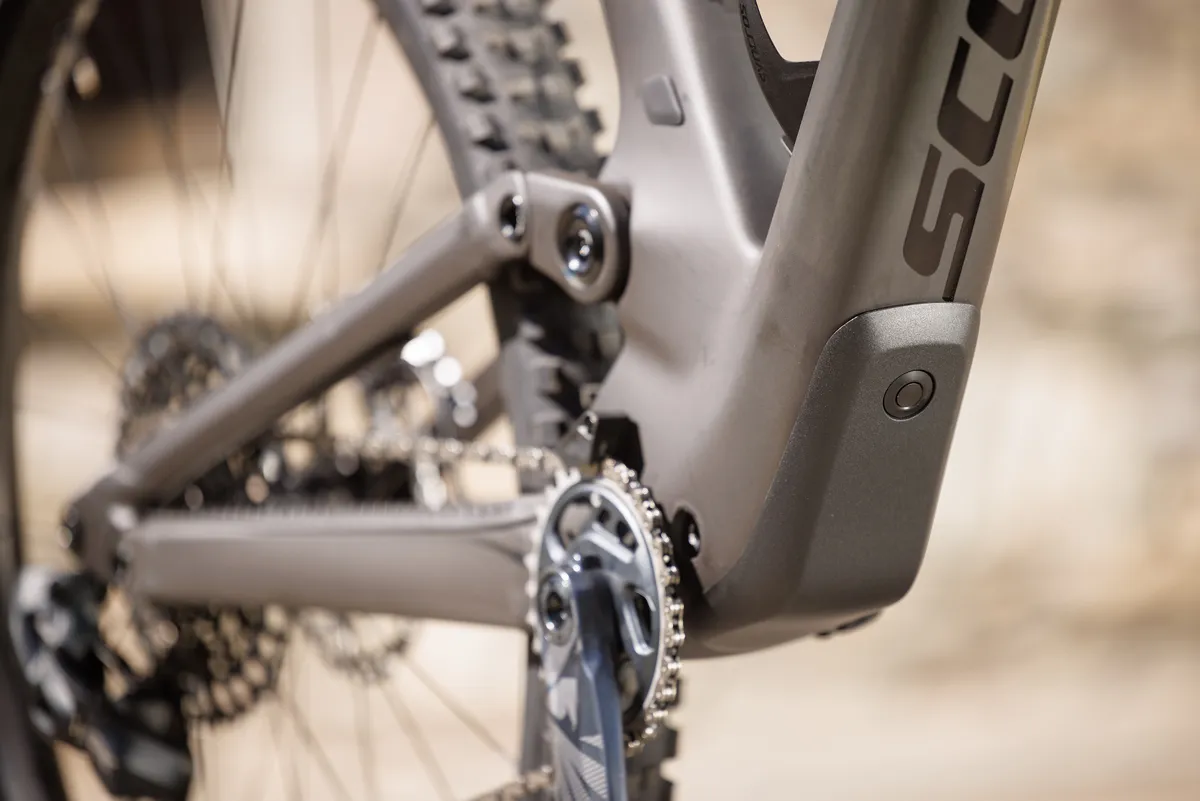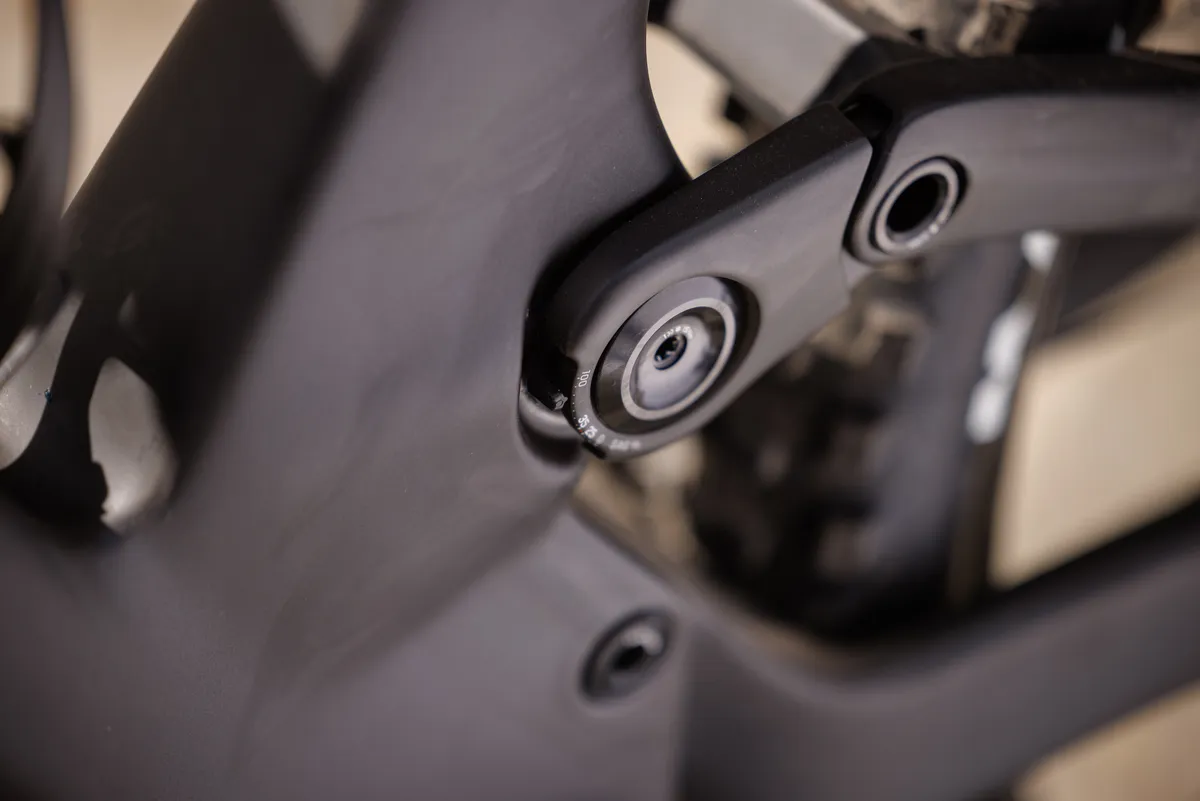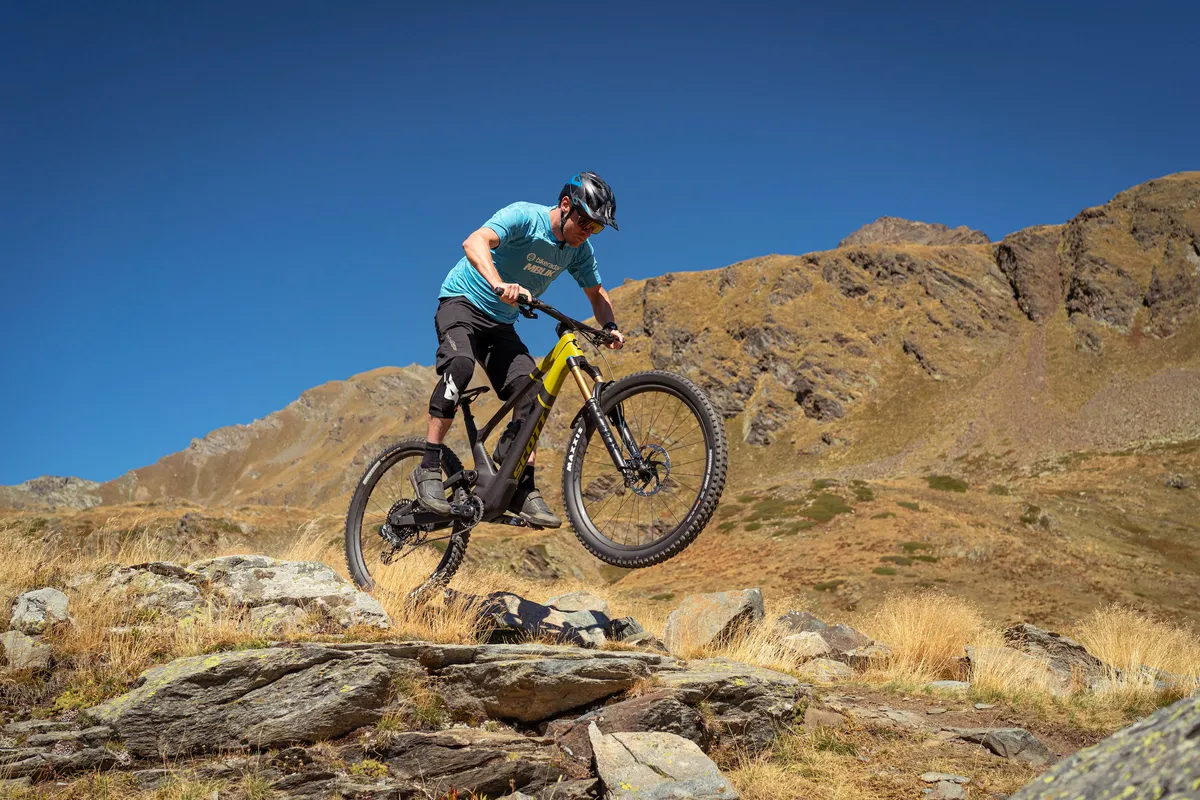Scott’s reimagined Genius Super Trail has a piggyback Fox X Nude shock hidden in the depths of the frame, using rocker link tech borrowed from the Scott Spark cross-country bike.
This 150mm-travel Genius Super Trail is designed as a burly trail mountain bike or all-mountain rig, utilising Scott's TwinLoc suspension system on the rear end only. Standard non-Super Trail Genius bikes get this tech on their fork and shock.
The full carbon fibre frame on this model encases the shock, but a neat door in the belly of the bike easily pops open, revealing the shock inside, while accessible Torx 30 bolts mean fitting and removing the shock should be a simple affair.
Scott Genius ST 900 Tuned frame details

The sleek-looking carbon frame provides a 4-bar suspension system delivering 150mm of travel. The tops of the seatstays push on a rocker, held by a pair of large bearings, that compresses the shock that sits between the bottom bracket and seatmast, enclosed by the structure of the frame.
Work has been done internally to ensure there’s enough room in the seatmast to take longer-drop dropper posts.
By hiding the shock internally, it's protected from the vast majority of water and dirt, which should result in more consistent performance, lower rates of wear and better shock longevity. However, Scott says shock service intervals still need to be adhered to.
A dial on the side of the top pivot bearing rotates when the suspension is compressed and, through friction, sticks at your sag level to show you how much travel you’re compressing the shock by. It’s easy to use, but not quite as obvious visually as an O-ring on a shock’s shaft – you have to get off the bike to see it.

Continuing the clean appearance, the rear brake hose enters the frame under the stem, going through the head tube, into the down tube and continuing to the rear caliper. It’s the same story for the TwinLoc cables, and on mechanical groupset models, the gear cable also.
Routing for the cables is detailed on the inside surface of the door to access the shock – a neat design touch, and one that should help home mechanics refresh their bike during servicing.
This door pops off with a pinned arrangement – superior to other doors I’ve used with a turn-key setup.

This door doubles as a bit of rock-strike protection, while the chainstays are protected by a rubber strip.
Scott Genius ST 900 Tuned suspension details

The Genius ST gets a custom-built Fox X Nude shock. The shock has a piggyback to increase oil volume. It features compression and rebound adjustment, as well as an adjustable air spring volume – this is fundamental to the TwinLoc system.
The TwinLoc system gives the bike three suspension settings – Descend, Ramp Control and Climb, controlled via an on-bar lever.

In Descend mode, the shock has full access to the whole air spring, the extra volume being held in a sleeve around the shock body, as well as fully open damping.
In Ramp Control mode, the air sleeve is closed, limiting the shock’s air volume – effectively like adding a huge volume spacer. This reduces the travel available to 60 per cent of what was there originally, while also holding the bike a little higher in its travel.
In Climb mode, the shock stays with this lower air volume, and the damping circuit is also closed off, giving a fairly firm lockout.
Toggling between modes via the on-bar lever is possible in individual clicks either way.
Scott Genius ST 900 Tuned geometry details
The geometry of the Genius Super Trail is bang up to date, with a fairly long (but not overly stretched) reach, a slack 63-degree head angle and a moderately steep 77.2-degree seat angle.
In a large, reach is 485mm, with all sizes getting 440mm chainstays. The bottom bracket sits 33mm below the axles, giving a BB height of 342.5mm.
The headset has an angle-adjust function – it’s quick and easy to do without having to cut the hydraulic lines that route through the bearings.
The top-cap of the headset arrangement needs to be removed, then the stem lifted. Cups set into the frame drop out and can be rotated to alter the angle.
On the Super Trail version of the bike, it’s set as Slack, which is where I imagine most riders will keep it.
| Size | Small | Medium | Large | Extra Large |
|---|---|---|---|---|
| Head tube length (mm) | 90 | 100 | 120 | 135 |
| Head angle (slack, degrees) | 63.9 | 63.9 | 63.9 | 63.9 |
| Top tube length (mm) | 570 | 602 | 631 | 659 |
| Standover (mm) | 729 | 739 | 754 | 769 |
| BB height (mm) | 432.5 | 432.5 | 432.5 | 432.5 |
| Wheelbase (mm) | 1,195 | 1,229 | 1,263 | 1,294 |
| Seat angle (degrees) | 77 | 77 | 77 | 77 |
| Chainstay length (mm) | 440 | 440 | 440 | 440 |
| Reach (mm) | 430 | 460 | 485 | 510 |
| Stack (mm) | 617 | 626 | 644 | 658 |
Scott Genius ST 900 Tuned specification details

The Tuned version of the bike is the top-spec model, and as such is suitably equipped with fancy kit.
At the front, there’s a 160mm Fox 36 Factory fork, with the Float X Nude shock also receiving the Factory treatment.
SRAM provides an X01 AXS groupset, with a GX AXS shifter, while Shimano’s XTR brakes with 203/180mm rotors are there to slow things down.

In-house brand Syncros provides plenty of other components. The wheels are the new carbon Revelstoke 1.0-30 CL hoops, shod in Maxxis Minion DHF and Dissector 2.6in tyres.
The cockpit is an integrated Syncros Hixon iC Carbon, with 15mm rise in S and M bikes, and 25mm rise in the L and XL. They’re 780mm wide, and, being a combined stem and bar, not adjustable in terms of bar roll. The Syncros Duncan dropper post comes in lengths from 140 to 200mm.
Scott Genius ST 900 Tuned ride impressions

This first ride review is based on a day and a half’s riding on the bike in Aosta, Italy, at the bike's launch.
The riding included a climb featuring fire roads and steep singletrack, before we rode steep, loose, dusty and rocky tracks to the bottom. As ever, I’d like to spend more time on the bike on familiar trails before giving a full report on its performance. As such, these are just initial impressions.
Scott Genius ST 900 Tuned climbing performance

The Genius has always had a fairly stable pedalling platform, with relatively low levels of pedal bob thanks to high-ish anti-squat levels.
This remains the case on the new bike, even with what feels like more descent-orientated intentions.
With the suspension open, and sat pedalling smoothly, there’s virtually no pedal bob to report on, while the rear wheel tracks smoothly over bumps and lumps.
As such, I wondered initially what the point of the TwinLoc on this bike really was.
When I took it to some steeper singletrack climbs, it became more obvious. The rear suspension firms up nicely, so stood-up efforts or less sympathetic pedal strokes don’t push the bike deeper into its travel. The bike is sat up a touch higher too, so pedal clearance on technical terrain feels good.

The Dissector tyre at the rear rolls fairly fast for an aggressive tyre, helping the bike feel quite pert on climbs.
The shape of the bike is comfortable on prolonged climbs. The top tube is long enough to give plenty of fore-aft movement to regulate traction, while the stem’s short 40m length means the bike doesn’t feel stretched.
Likewise, the steep seat angle puts hips nicely over the BB. With the Ramp Control mode engaged, the bike doesn’t sag dramatically, slackening the seat angle, and so even on steep tracks, that steeper seat angle is fairly well maintained.
Overall, I’d say it’s marginally better uphill than the also recently released Trek Fuel EX, which has similar intentions on the trail.
Scott Genius ST 900 Tuned descending performance

Down hills, the Genius Super Trail showed plenty of promise.
The shape is aggressive, without being so long that it’s a handful to handle. There’s a good blend of high-speed stability and confidence on steep and technical terrain, while still being agile enough to lift the front end up easily, or slap the rear wheel through a corner.
As such, it proved an incredibly engaging bike to ride on the loose, rocky trails I tested it on. A squeeze of the rear brake enabled me to steer with the rear wheel through tight turns, while when the trail dipped into a steep catch berm, I wasn’t afraid to weight the front wheel and carry as much speed as I could through it.
Through rough cobbled tracks, the rear suspension kept the bike nicely in control. It’s not the smoothest bike I’ve ever ridden – if you like complete isolation from the trail, you might find the feedback through the frame and pedals a little more than you’d like.
However, I think Scott has the balance right. It’s communicative, yet controlled.

In the mid-stroke, there’s acres of support. This means the bike feels as if it has tons of pop, while at the same time, the suspension stays propped up through repeated hits, when run with 30 per cent sag and only a couple of clicks of compression damping (from fully open) on the shock.
Though the sag meter shows I did bottom the bike out, I don’t know when that happened. There was no harsh clunk and there were no dicey feelings going on.
I did some descending in the Ramp Control mode (not entirely on purpose). Scott says this mode can be used on smooth flow trails, where the added support of the air spring would make pumping through the terrain very efficient.
Though I didn’t get all the travel, the open nature of the damping in this mode meant the trail still felt relatively smooth. I only really noticed when I hit some slightly more involved terrain and realised it was getting a little out of its depth.
Taking the rough with the smooth

The chassis is stiff – especially the front end. This gives it authority when you’re pushing the bike through corners. However, with the stiff carbon hoops fitted too, it was possible to get the front tyre to skip out a touch when pushing hard over rocks.
The stiff frame, wheels and combined bar/stem also detracted a touch from the overall ride quality over rocks, with hand pain a slight issue towards the end of the descents.
I’d prefer the non-integrated bar/stem option found on cheaper bikes, at the very least to also give extra adjustability in fit, and the possibility to fit a wider, 800mm bar.
The other issue I found was that the rear rotor’s 180mm diameter didn’t give me enough power on longer descents.
For a bike with a sturdy fork and stout chassis, a 200 or 203mm rotor at the rear makes sense – more power with minimal weight gain.
I, and others on the launch, suffered from significant arm pump, especially as the four-piston XTR brakes don’t quite have the progressive power that some other stoppers provide.

A larger rear rotor would be the first upgrade I’d make to the bike.
The rest of the kit worked well. Maxxis’ Minion DHF is a stellar tyre at the front in a broad range of conditions, and while the Dissector isn’t the most aggressive, it doesn’t harm rolling speed up or down hills.
The TwinLoc lever system is a little divisive. It works well, and is effective on punchy climbs. However, the lever is still a little clunky, with three individual paddles under your left thumb (two for TwinLoc, one for the dropper).
I occasionally pressed the shock adjuster instead of the dropper, though with time I’m sure you’d get used to it. It’s also a little closer to your knee, in the event of a crash.
While the Genius Super Trail might not have jumped out as being wildly better than other bikes on the market, what’s clear is that Scott has built an incredibly capable aggressive trail bike.
The combination of decent geometry, sorted suspension and, for the most part, good spec details, means I’m very much looking forward to spending more time on the bike to learn more about how it rides on my local tracks.
Product
| Brand | scott |
| Price | 10999.00 EUR,10999.00 GBP,10999.99 USD |
Features
| Fork | FOX 36 Float Factory |
| br_chain | SRAM CN X01 Eagle |
| br_frame | Genius Carbon HMX |
| Tyres | Maxxis Minion DHF / 2.6” / 120TPI Foldable, Tubeless Ready / EXO 3C maxxTerra F, Maxxis Dissector / 2.6” / 60TPI Foldable, Tubeless Ready / EXO 3C maxxTerra R |
| br_brakes | Shimano XTR M9120 |
| br_cranks | SRAM X01 DUB Eagle Carbon crankarm, 55mm CL / 32T |
| br_saddle | Syncros Tofino 1.5 |
| br_wheels | Syncros Revelstoke 1.0-30 CL, |
| br_headset | Syncros - Acros Angle adjust & Cable Routing HS System |
| br_shifter | SRAM GX Eagle AXS |
| br_cassette | SRAM X01 XG1295 / 10-52 T |
| br_seatpost | Syncros Duncan Dropper Post 1.5, 31.6mm / S size 140mm / M size 160mm, L size 170mm / XL size 200mm |
| br_gripsTape | Syncros Endurance lock-on |
| br_handlebar | Syncros Hixon iC Carbon, Size S & M 15mm rise / Size L & XL 25mm rise, back sweep 8° / 780mm, |
| br_rearShock | FOX FLOAT X NUDE Factory EVOL Piggy Back Trunnion |
| br_bottomBracket | SRAM BUB |
| br_availableSizes | S, M, L, XL |
| br_rearDerailleur | SRAM X01 Eagle AXS |

